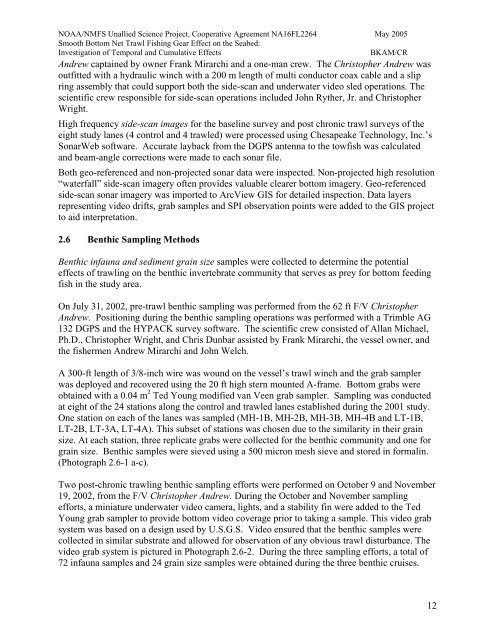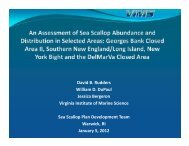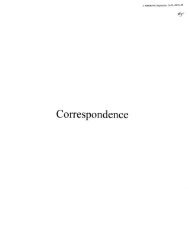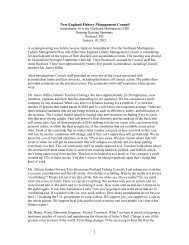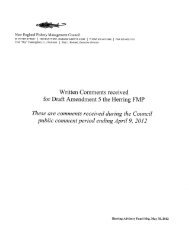Smooth Bottom Net Trawl Fishing Gear Effect on - New England ...
Smooth Bottom Net Trawl Fishing Gear Effect on - New England ...
Smooth Bottom Net Trawl Fishing Gear Effect on - New England ...
Create successful ePaper yourself
Turn your PDF publications into a flip-book with our unique Google optimized e-Paper software.
NOAA/NMFS Unallied Science Project, Cooperative Agreement NA16FL2264 May 2005<br />
<str<strong>on</strong>g>Smooth</str<strong>on</strong>g> <str<strong>on</strong>g>Bottom</str<strong>on</strong>g> <str<strong>on</strong>g>Net</str<strong>on</strong>g> <str<strong>on</strong>g>Trawl</str<strong>on</strong>g> <str<strong>on</strong>g>Fishing</str<strong>on</strong>g> <str<strong>on</strong>g>Gear</str<strong>on</strong>g> <str<strong>on</strong>g>Effect</str<strong>on</strong>g> <strong>on</strong> the Seabed:<br />
Investigati<strong>on</strong> of Temporal and Cumulative <str<strong>on</strong>g>Effect</str<strong>on</strong>g>s BKAM/CR<br />
Andrew captained by owner Frank Mirarchi and a <strong>on</strong>e-man crew. The Christopher Andrew was<br />
outfitted with a hydraulic winch with a 200 m length of multi c<strong>on</strong>ductor coax cable and a slip<br />
ring assembly that could support both the side-scan and underwater video sled operati<strong>on</strong>s. The<br />
scientific crew resp<strong>on</strong>sible for side-scan operati<strong>on</strong>s included John Ryther, Jr. and Christopher<br />
Wright.<br />
High frequency side-scan images for the baseline survey and post chr<strong>on</strong>ic trawl surveys of the<br />
eight study lanes (4 c<strong>on</strong>trol and 4 trawled) were processed using Chesapeake Technology, Inc.’s<br />
S<strong>on</strong>arWeb software. Accurate layback from the DGPS antenna to the towfish was calculated<br />
and beam-angle correcti<strong>on</strong>s were made to each s<strong>on</strong>ar file.<br />
Both geo-referenced and n<strong>on</strong>-projected s<strong>on</strong>ar data were inspected. N<strong>on</strong>-projected high resoluti<strong>on</strong><br />
“waterfall” side-scan imagery often provides valuable clearer bottom imagery. Geo-referenced<br />
side-scan s<strong>on</strong>ar imagery was imported to ArcView GIS for detailed inspecti<strong>on</strong>. Data layers<br />
representing video drifts, grab samples and SPI observati<strong>on</strong> points were added to the GIS project<br />
to aid interpretati<strong>on</strong>.<br />
2.6 Benthic Sampling Methods<br />
Benthic infauna and sediment grain size samples were collected to determine the potential<br />
effects of trawling <strong>on</strong> the benthic invertebrate community that serves as prey for bottom feeding<br />
fish in the study area.<br />
On July 31, 2002, pre-trawl benthic sampling was performed from the 62 ft F/V Christopher<br />
Andrew. Positi<strong>on</strong>ing during the benthic sampling operati<strong>on</strong>s was performed with a Trimble AG<br />
132 DGPS and the HYPACK survey software. The scientific crew c<strong>on</strong>sisted of Allan Michael,<br />
Ph.D., Christopher Wright, and Chris Dunbar assisted by Frank Mirarchi, the vessel owner, and<br />
the fishermen Andrew Mirarchi and John Welch.<br />
A 300-ft length of 3/8-inch wire was wound <strong>on</strong> the vessel’s trawl winch and the grab sampler<br />
was deployed and recovered using the 20 ft high stern mounted A-frame. <str<strong>on</strong>g>Bottom</str<strong>on</strong>g> grabs were<br />
obtained with a 0.04 m 2 Ted Young modified van Veen grab sampler. Sampling was c<strong>on</strong>ducted<br />
at eight of the 24 stati<strong>on</strong>s al<strong>on</strong>g the c<strong>on</strong>trol and trawled lanes established during the 2001 study.<br />
One stati<strong>on</strong> <strong>on</strong> each of the lanes was sampled (MH-1B, MH-2B, MH-3B, MH-4B and LT-1B,<br />
LT-2B, LT-3A, LT-4A). This subset of stati<strong>on</strong>s was chosen due to the similarity in their grain<br />
size. At each stati<strong>on</strong>, three replicate grabs were collected for the benthic community and <strong>on</strong>e for<br />
grain size. Benthic samples were sieved using a 500 micr<strong>on</strong> mesh sieve and stored in formalin.<br />
(Photograph 2.6-1 a-c).<br />
Two post-chr<strong>on</strong>ic trawling benthic sampling efforts were performed <strong>on</strong> October 9 and November<br />
19, 2002, from the F/V Christopher Andrew. During the October and November sampling<br />
efforts, a miniature underwater video camera, lights, and a stability fin were added to the Ted<br />
Young grab sampler to provide bottom video coverage prior to taking a sample. This video grab<br />
system was based <strong>on</strong> a design used by U.S.G.S. Video ensured that the benthic samples were<br />
collected in similar substrate and allowed for observati<strong>on</strong> of any obvious trawl disturbance. The<br />
video grab system is pictured in Photograph 2.6-2. During the three sampling efforts, a total of<br />
72 infauna samples and 24 grain size samples were obtained during the three benthic cruises.<br />
12


